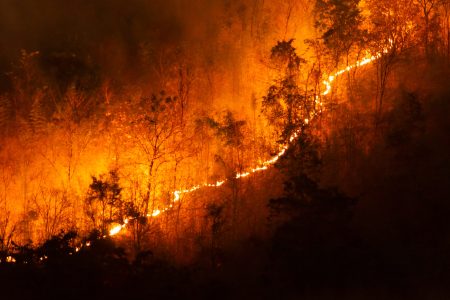This year we have witnessed one of the most dangerous wildfire seasons yet, so what are the best practices and tools to prepare communication channels?
Every year, wildfires break new records. By August of 2021 alone, over two million acres of land have been burned, hundreds of homes and other structures destroyed, and many more families displaced. Thousands of firefighters and other emergency workers are continually at risk of serious injury or death. Businesses close, entire communities grind to a halt. And worse yet? The fires are getting more severe, and wildfire seasons are lasting longer.
While an obvious hazard to anyone, wildfires can be particularly challenging for businesses. One of the biggest challenges they face during a wildfire is communication. Wildfires can grow from a small brush fire into an inferno that engulfs thousands of acres in a matter of hours, leaving little time to react.
In 2020 the LA Times reported the challenges that county officials in California faced when trying to send evacuation alerts. Some messages were delivered to too many people, others to too few, and still others failed to send at all—due to the complexity of the county’s emergency communication system and coding errors.
Having the right technology, processes, and training in place can ensure those in harm’s way are given the information they need to protect themselves and their loved ones at a moment’s notice. In this article, we’ll go over best practices and tools you can use to make sure your wildfire communication is poised to save lives and protect your organisation.
Preparation for all
Government agencies and businesses alike struggle to effectively manage a wildfire situation. Often, their challenges begin with the misconception that, as long as first responders and business leaders can communicate with each other, the emergency response plan is sufficient.
In fact, one of the most common mistakes made by government agencies and businesses is to simply not communicate about threats until it’s too late. As Stan Szyptek, President and CEO at Fire & Life Safety, says about his experiences with his clients, “Where many [businesses] could have done better was that they didn’t have communication capabilities in place to provide that warning.”
Communication with these groups can be difficult, but there are some best practices to keep in mind when doing so. Communication challenges before, during and after a wildfire can be solved with the following strategies:
Before a wildfire
There’s no use waiting until you’re forced to evacuate to think about wildfire preparedness. Rather, make sure to prepare ahead of time. Before a disaster like a wildfire strikes, it’s important to know how you’re able to get in touch with everyone in your organization. And not just your employees. You might also need to reach your customers, suppliers, or even the public, depending on your location and the type of work your organization does. This plan should also include a mass notification system that can reliably reach that wide audience.
Gather as much contact information from your audience as possible, such as phone numbers, emails, home addresses, and the like. These redundancies will allow you to take advantage of multi-channel emergency notification systems later. Some tools even allow you to monitor user locations via location data from a mobile app.
Seek out tools and methods to help you assess your organization’s level of wildfire risk, as well as the risk to individuals and specific business units. Communicate expectations to your team so they are prepared if and when a wildfire sparks to life in your area.
When a wildfire is approaching, the last thing you want to have to do is troubleshoot technology. After preparing your communication plan and tools, you need to test everything to make sure it’s ready to go. Send your audience test messages, and identify anyone who didn’t receive them to expose errors.
Your emergency managers and employees will feel more comfortable in an emergency if they know that they can rely on you for prompt, helpful information.
During a wildfire
When the sky turns orange and a wildfire nears, it’s crucial to have a stream of up-to-date, reliable information on the status of the fire. Your local police and fire authorities are the best resources for this, but local news and even social media can hold valuable information. Some emergency notification systems, such as AlertMedia’s, are able to natively integrate threat intelligence feeds from vetted sources and even in-house analysts.
Employing a robust notification system will do wonders for your organization’s wildfire communications capabilities, but even still you have to focus on message frequency. If your users rarely receive any communication from you, they might feel abandoned and uncertain about what to do, which can leave them in harm’s way.
Then again, sending too many notifications can induce “notification fatigue.” After being bombarded with alerts, people tend to ignore or even disable them. Walking this line is a balancing act, but it can drastically increase the effectiveness of your wildfire messaging. If you find that a situation calls for more frequent updates, as a large wildfire might, you can set up a landing page such as AlertMedia’s event pages. Here you can gather additional info that you wouldn’t want to include in your alerts. These might include multimedia elements like news stories or images.
After a wildfire
When a wildfire is finally contained or dies out, emergency managers collectively sigh with relief. However, there’s still work to be done. Before you can resume business as usual, you have to check in with all of your people and assess the damage to your business or property. Surveys and read confirmations are perfect tools to check on everyone: multiple-choice questions can quickly identify who needs help, and read receipts can give you peace of mind that the right people saw the alerts they need to.
Some employees impacted by the fire might not be able to work, or must work in a new location due to road closures, property damage, or personal grief. Communicating in-office and remote work policies and procedures to your company will get your business up and running again as soon as possible. Be sure to remind your employees of the resources available to them so they can get back on their feet.
It’s paramount to have a communication plan in place that takes all of this into account, but even then there are some common roadblocks to keep in mind. We’ve broken down some of the most difficult elements of communicating during a wildfire and provided solutions so that your safety plan runs smoothly.
Uncertainty about message receipt
With many emergency communication solutions, it’s difficult to know whether a message reached its intended audience. Often, a business utilizes one or two communication channels, such as phone and email, with no way to know if the intended recipient listened to or opened the alert.
Businesses need to leverage every line of communication they can, including phone calls, email, texting, mobile app push notifications, social media, and intranet sites. An integrated, multichannel communication system gives businesses a quick way to reach all employees, no matter which device they’re using, and track the read rates of each message.
Inconsistent messages
Without the use of pre-built templates or clear protocols, it’s easy for messages to miss their mark. One study by the University of Oregon found that emergency messages during a wildfire are often conflicting or confusing, and that information was old or inaccurate. This is especially true if multiple, uncoordinated agencies are sending messages.
An effective emergency communication system should offer templates that a user can pre-build for different situations, such as a wildfire. You should take your time developing concise messaging in times of calm that you can instantly access and send in times of emergency. You should then segment messages according to the audience to reduce irrelevant information and ensure the right message is getting to the right people at the right time.
Misaligned internal priorities
Unfortunately, many businesses downplay the importance of emergency communications. Even State and Federal governments fail to properly prioritise communication in inter- and intra-agency situations and in cases of public safety.
We cannot overstate the value of communications to wildfire mitigation. Getting executive buy-in will ensure communication is a priority in your emergency response plan. Companies should invest in a comprehensive emergency communication system that gives businesses the ability to protect employees and maintain business continuity.
Lack of training
As witnessed in the Sonoma County fires, all of the technology in the world won’t do much good if the people tasked to use it aren’t trained. Speed is paramount in an emergency. The longer it takes someone to figure out the communication system, the more lives are at risk.
Training should be at regular intervals with full role-playing involved. Businesses should expect every person with responsibility in the emergency plan to complete the training together in order to perfect coordinated efforts. Promote regular use of consistent communication on the system, establishing best practices along the way. Appoint skilled users as educators to lead and train others.
Inadequate technology
Some businesses lack appropriate emergency communication technology. Others use piecemeal email, phone, and internal communication systems. Still others have systems they don’t use properly. Conflicting and inconsistent use of technology causes confusion, drains resources, and wastes precious time.
Technology doesn’t have to be complex. Invest in a single, integrated emergency communication system that offers flexible, scalable functionality. Make sure the people who will be using the technology receive proper training. They should be completely comfortable with it so that in an emergency they can activate it without delay.
Roy Wilsher, Chair of the National Fire Chiefs Council
These large-scale fires are a stark reminder as to just how quickly these types of fires take hold. It is yet another example of why fire services need to be resourced to risk, as well as demand.
It is evident to see how much resources have been needed globally to deal with these fires; last year we saw the highest number of grass fires in recent history and this pattern is being repeated, year on year.
As part of our resilience work, we have worked around the clock to assist and support fire services dealing with these incidents globally. These plans will remain in place for the near future and I would like to thank everyone for their tireless work.
The work will include looking at what type of support would be most useful, how long it may be required and to ensure any further assistance is in line and coordinated with firefighting efforts currently underway in places such as Australia.
The UK fire service representation is part of NFCC’s National Resilience capability. This will include meeting with local fire and local authorities to identify if UK Fire are in a position to offer further ongoing support overseas. The government meeting discussed the current situation, predicted future demands and the UK offer of assistance – and other support – which could be available.
During times of national and international disaster, the UK ISAR Team (International Search and Rescue) can be deployed to assist – and a team can be mobilised within six hours.
We reiterate time and time again the dangers of barbecues or other flammable materials during dry weather spells and being careless with rubbish and cigarettes. Unfortunately we have seen irreplaceable wildlife and wild areas destroyed due to irresponsible behaviour.
Simon Bingham, Senior Account Manager at Radiocoms Systems
Reliable communication, no matter what the incident is, is essential both for calls coming through to the fire station, ensuring that the appropriate fire appliances and crews are dispatched, through to the handheld devices the firefighters use to communicate with the fire station when they’re heading to an incident.
What happens in a typical fireground set up is that once the 999 call is made and the incident is booked into the system, the call goes to the fire station and the appropriate fire appliances and crews are dispatched. The fire appliances are equipped with mobile radios, which use the nationwide emergency services communications network.
On the way to the fire or incident, the firefighters use the network to talk to each other and to the dispatcher in the command and control centre and to collect information on the incident on the way to the fire.
However, once the firefighters are at the scene of the fire, they then rely on their hand portable two-way radios whilst managing the task at hand. It’s at this stage that having durable and fall-proof solutions is most essential.
In a typical fire, you’ll have a team outside damping down the fire, spraying water and so on, and breathing apparatus (BA) teams working in pairs, who are counted in and out of the building by the Entry Control Officer. They use two separate radio channels: a BA channel and an incident channel. The National Operational Guidance (NOG) for the fire service provides a standardised channel plan.
To stay up to date on the latest, trends, innovations, people news and company updates within the global fire market please register to receive our newsletter here.
Media contact
Rebecca Morpeth Spayne,
Editor, International Fire Buyer
Tel: +44 (0) 1622 823 922
Email: editor@firebuyer.com









